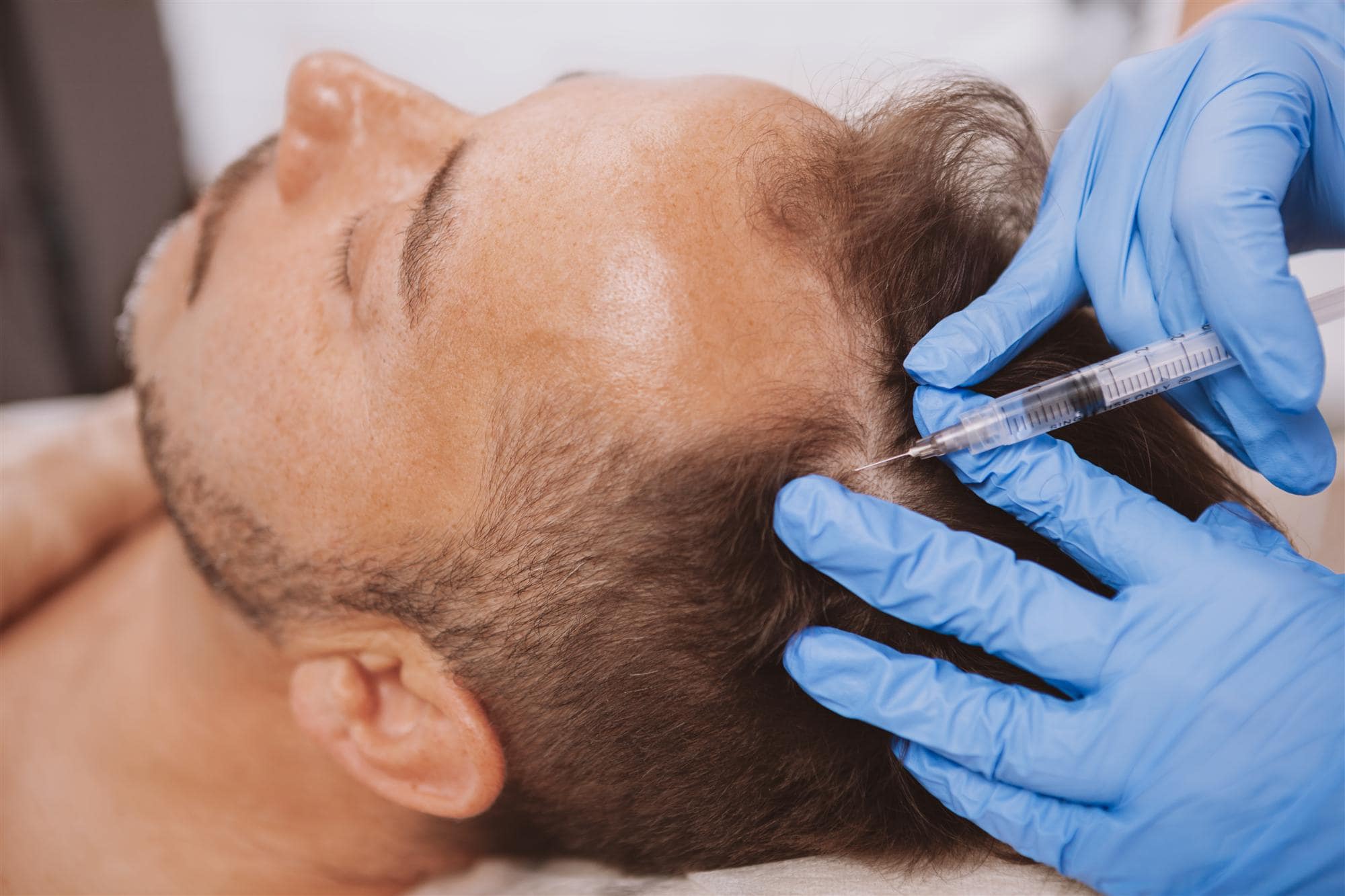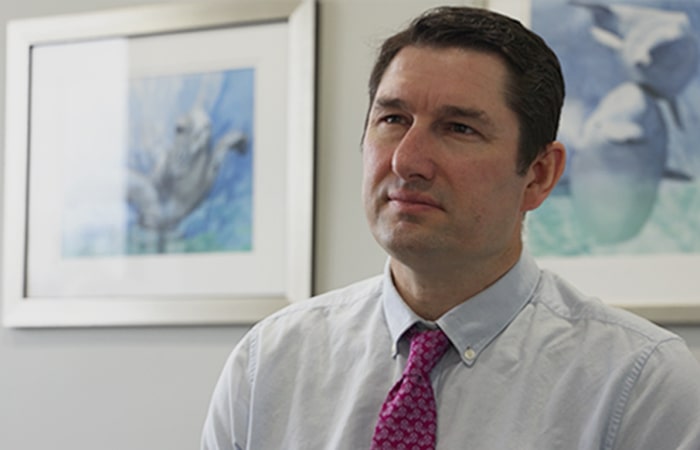
Understanding Hair Loss Treatments: An Overview
Hair loss affects over 80% of men and nearly 50% of women. It doesn’t discriminate by age or gender. Anyone can experience extensive hair loss in their lifetime, and it’s important to understand how to effectively fight it.
DCP offers a full range of proven medical and surgical hair loss treatments to help both men and women restore their hair. Knowing the degree and potential causes of your hair loss will help you choose the best treatment plant.
Table of Contents

What is Hair Loss?
Alopecia, the medical term for hair loss, occurs when the normal shedding of hair outpaces the growth of new hair. Androgenic alopecia accounts for over 95% of hair loss cases and occurs when dihydrotestosterone (DHT) binds to hair follicle receptors, causing the follicles to shrink and stop producing new hair. 42% of men experience androgenic alopecia between the ages of 18 and 49.
What Causes Hair Loss?
Hair loss can occur for many reasons. Finding the cause is essential to finding the appropriate treatment.
Common causes of hair loss include:
- Genetics: Androgenic alopecia is the most common form of genetic hair loss. People with a genetic predisposition to male or female pattern baldness usually first notice the gradual thinning of their hair.
- Age: As people get older, some degree of age-related shedding is common even if they aren’t genetically predisposed. Despite hair loss being a normal part of aging, it can still be distressing.
- Medical Conditions: Illnesses like thyroid disorders, autoimmune diseases, nutritional deficiencies and scalp fungal infections can trigger temporary or permanent hair loss. Treating the underlying problem may help hair regrow.
- Medications: Cancer treatments, birth control pills, antidepressants and other drugs can sometimes cause hair loss as a side effect.
- Hairstyles: Consistent traction on hair from tight braiding, ponytails, cornrows and extensions can damage follicles and cause permanent hair loss.
The wide range of potential reasons for hair loss means getting an accurate diagnosis from a dermatologist is key to a successful treatment.
When to Start Hair Loss Treatments
Starting treatment at the first signs of hair thinning or excess shedding is critical to preventing further loss. The earlier you start treating your hair loss, the better the treatments work to stop the hair loss from progressing.
If significant bald spots have already developed, restoring the coverage of your hair becomes more challenging. Starting treatment as soon as possible can still help improve results. The first step is to consult a dermatologist to evaluate the degree of loss and determine which interventions will be most effective. Acting quickly gives treatments like transplants and medications the best chances of success before damage becomes too advanced. Consistency is also key. Sticking with a regimen for at least six months is required to accurately gauge its efficacy.
Non-surgical Hair Loss Treatments Explained
If you've caught hair loss early, you likely don't need to immediately turn to surgical procedures. Effective non-surgical options can help counteract thinning and shedding, helping you regrow fuller, healthier hair when used consistently.
Hair Supplements
Minoxidil is a common over-the-counter supplement used to treat hair loss alone or as part of a hair loss treatment regimen. While prescription pharmaceuticals can be very effective, they may come with potential side effects and require a doctor’s supervision. Minoxidil helps prolong the growth phase and revive shrinking hair follicles. It often works best when paired with treatments like finasteride.
Alongside treatments like Minoxidil, making sure to get adequate vitamins and minerals through your diet or supplementation provides the necessary nutrients to support healthy hair follicles. Supplementing biotin, zinc, iron, vitamin D and vitamin A can help support the strength of existing hair and follicles. Consult a dermatologist to determine which combination of medications and natural supplements may produce optimal results for your hair.
Medical Therapy
Finasteride and dutasteride are hair loss medications used to block the production of DHT, the hormone responsible for causing male and female pattern baldness. Finasteride (commonly known as Propecia) is approved for use in men only, while dutasteride is used off-label for hair loss in both men and women. These drugs work by preventing testosterone from converting to DHT.
Results can take 3-6 months to become noticeable. One study has shown finasteride to improve hair growth in 48% of men at one year and 66% of men at two years of consistent application. When taking finasteride, consistency is vital. If treatment is stopped, the benefits can be lost.
Spironolactone is an androgen-blocking drug used off-label for female pattern hair loss. It curbs androgen activity and has the potential to support hair growth. These medications work best for women with thinning related to hormonal changes from menopause or polycystic ovary syndrome. Medical supervision is required due to possible side effects.
For both men and women, prescription medical therapy remains one of the most effective options for stopping genetic hair loss and encouraging new regrowth.
Platelet-Rich Plasma Injections
Platelet-Rich Plasma (PRP) therapy is an effective treatment for stimulating hair growth in both men and women suffering from common forms of hair loss. The treatment involves drawing a patient’s blood, isolating the plasma containing concentrated growth factors and injecting it into thinning areas of the scalp.
PRP injections are most effective when used in conjunction with another treatment like minoxidil and are significantly more effective than using minoxidil alone. PRP’s effects are thought to be most pronounced when started in the early stages of hair loss, but results can vary based on the health of your platelets.
Surgical Hair Loss Treatments
For permanent hair restoration, surgical hair treatments can be an effective option. The two main surgical techniques are follicular unit extraction (FUE) and follicular unit transplantation (FUT). An experienced surgeon can evaluate your hair loss pattern and scalp laxity to determine which procedure will yield the most natural results.
Follicular Unit Extraction (FUE)
Follicular Unit Extraction is a minimally invasive hair transplant technique. During FUE, grafts containing 1-4 hairs are individually extracted from the back and sides of the scalp using a small punch, leaving tiny dotted scars. The follicles are then transplanted into the balding areas where you want new hair. Unlike FUT, the extraction does not leave a linear scar and the recovery time is faster. Robotic FUE systems like the ARTAS robot are now available to automate the process. When performed properly by a skilled surgeon, FUE can produce natural-looking results with a low risk of complications.
Follicular Unit Transplantation
Follicular Unit Transplantation (FUT) is a common type of hair transplant procedure. During FUT, a linear strip of the scalp is surgically removed from the back of the head. The excised strip is then dissected to isolate individual follicular units containing 1-4 hairs. These grafts are meticulously implanted in the balding areas needing restoration. FUT typically has a quicker harvesting phase, but it does leave a permanent linear scar where the strip was extracted. When performed by a skilled surgeon, FUT transplants can produce natural, permanent outcomes.
FUE vs FUT Hair Transplants
While both FUE and FUT transplant hair follicles from the back and sides of the scalp to thinning areas, there are some key differences.
FUE involves extracting grafts individually, leaving tiny puncture wounds that heal relatively quickly. FUE requires no scalpel or stitches and leaves no linear scar. FUT takes a strip of skin from the back of the head and it is dissected into grafts, leaving a permanent linear scar. However, FUT allows retrieving more grafts per session and has a shorter harvest time.
When properly performed by an expert, both procedures can produce natural results. Consulting an experienced surgeon can help determine which technique is most suitable for you.
ARTAS Robotic Hair Transplants
ARTAS robotic hair restoration utilizes advanced technology to automate the transplant process for precise and minimally invasive results. During the ARTAS procedure, a robotic arm equipped with a micron-level camera and sophisticated algorithms harvests healthy follicles from the back and sides of the scalp. The collected grafts are then implanted into thinning areas by the same robot or a technician.
The ARTAS system can transplant up to 1,000 follicular unit grafts per session. Patients experience minimal discomfort and quick recovery times compared to traditional transplant methods. After around 9 months, patients can enjoy restored hairlines and increased confidence.
Preparing for a Hair Loss Procedure
Undergoing a surgical hair restoration procedure requires planning and preparation for optimal results. It's important to follow all pre and post-procedure instructions from your doctor.
Helpful steps include:
- Discuss realistic outcomes, recovery times and follow-up care with your surgeon
- Stock up on recommended medications, comfort aids and post-op supplies
- Take prescribed pre-procedure medications
- Arrange your schedule so you can focus on healing and attend all follow-up appointments
- Avoid blood thinning medications or supplements beforehand
- Take pre-procedure photos to compare your progress
Being proactive and preparing for a hair transplant procedure or extraction can help ensure proper healing and maximize your satisfaction.
 Dr. Burt Steffes
Dr. Burt Steffes
Board-Certified Dermatologist
Dr. Burt Steffes is a highly skilled and compassionate board-certified dermatologist with a passion for providing exceptional care and natural-looking results to his patients at Dermatology & Cosmetic Physicians. With over a decade of experience specializing in cosmetic and medical dermatology, Dr. Steffes combines his extensive training, modern technology, and personalized approach to help his patients achieve their skincare goals with confidence and peace of mind.
Back To Blog
Find the Right Hair Loss Solution for You
Schedule a consultation with Dr. Burt Steffes at DCP to find the perfect hair loss treatment for you. Dr. Steffes will evaluate your goals, the degree of hair loss and hair characteristics to customize a treatment plan or procedure to help you achieve lasting, natural-looking results.

 Why Choose DCP
Why Choose DCP